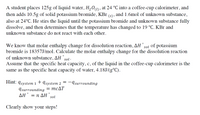
Chemistry
10th Edition
ISBN: 9781305957404
Author: Steven S. Zumdahl, Susan A. Zumdahl, Donald J. DeCoste
Publisher: Cengage Learning
expand_more
expand_more
format_list_bulleted
Question
An energy change called enthalpy of solution, ΔHsol, occurs when a substance dissolves in water.

Transcribed Image Text:A student places 125g of liquid water, H,01), at 24 °C into a coffee-cup calorimeter, and
then adds 10.5g of solid potassium bromide, KBr (s) , and 1.6mol of unknown substance,
also at 24°C. He stirs the liquid until the potassium bromide and unknown substance fully
dissolve, and then determines that the temperature has changed to 19 °C. KBr and
unknown substance do not react with each other.
We know that molar enthalpy change for dissolution reaction, AH
bromide is 18357J/mol. Calculate the molar enthalpy change for the dissolution reaction
of unknown substance, AH sol·
sol
of potassium
Assume that the specific heat capacity, c, of the liquid in the coffee-cup calorimeter is the
same as the specific heat capacity of water, 4.18J/(g°C).
Hint: 9system 1+ ąsystem 2
-Asurrounding
Isurrounding = MCAT
AH° = n AH sol
Clearly show your steps!
Expert Solution
This question has been solved!
Explore an expertly crafted, step-by-step solution for a thorough understanding of key concepts.
Step by stepSolved in 2 steps with 3 images

Knowledge Booster
Learn more about
Need a deep-dive on the concept behind this application? Look no further. Learn more about this topic, chemistry and related others by exploring similar questions and additional content below.Similar questions
- at a certain temperature,1.85 grams of barium hydroxide will dissolve to form 100.0 ml of a saturated barium hydroxide solution. the molar mass barium hydroxide is 171.34 grams/mole. what is the concentration of the solution in unit molarity? what is the constitution of the hydroxide ion in the same solution?arrow_forward5.00 g of solid Al(NO3)3 was added to enough water to make a solution with a total volume of 100.0 mL. Al(NO3)3 is very soluble in water and this much solid will fully dissolve in a 100.0 mL solution. If 65 mL of water was added to the original 100.0 mL Al(NO3)3 solution described to the left in order to dilute the solution. Calculate the new diluted solution concentration, in Molarity? Assume the volumes of the 2 solutions are additive.arrow_forwardThe solubility of an ionic solid is 122.7g/100g of water at room temperature. What is the maximum amount of ionic solid that will dissolve in 94.79g of water at this temperature?arrow_forward
- A solution of CaCl₂ in water forms a mixture that is 35.0% calcium chloride by mass. If the total mass of the mixture is 517.0 g, what masses of CaCl₂ and water were used? mass of CaCl₂: mass of water: g garrow_forwardThe solubility product constant for a certain metal phosphate, M3(PO4)2 is Ksp = 2.1 × 10−27. Its molar mass is ℳ = 279.04 g/mol. What is its solubility in g/L? Report your answer to TWO significant figures. Enter your answer in scientific notation using the appropriate boxes. Remember, a number like 1.6, in scientific notation is 1.6 × 100.arrow_forwardYou dissolve 9.9 mmol of sodium bicarbonate into a total volume of 4.31 mL. What is the molarity of sodium bicarbonate in the resulting solution. (Give your answer in units of M, with two places after the decimal point.)arrow_forward
- Most biological reactions take place in an aqueous (water-filled) environment. For example, salts like NaCl readily dissolve in water. However, NaCl is not soluble in a solvent like benzene. Based on what you know about the chemistry of water, explain why this is the case.arrow_forwardA bottle of anhydrous copper(II) sulfate was accidentally left uncapped for an afternoon, allowing it to pick up water from the environment. To determine the degree to which the compound was hydrated, a sample was analyzed. The initial weight of the partially hydrated copper(II) sulfate was 9.782. After drying to constant weight, the weight was 7.232. How may waters of hydration are present?arrow_forwardCalculate the molarity of a solution containing 306.5 g of Mg(NO3)2 per liter of water. The solution has a density of 1.114 g/mL. Density of water is 1.00 g/mLarrow_forward
- Explain how water is able to dissolve calcium chloride (CaCl2). Be sure to use appropriate terminology in your answer. You may use a diagram to aid your explanation.arrow_forwardWhen 13.99 mL of HCl of unknown concentration (but less than that of the base) are reacted with 15.00 mL of 3.172 M NaOH, 1.74 kJ of heat are released. What is the molarity of the HCl solution?arrow_forwardA solution is made by dissolving 29.3 g of aluminum chloride, AlCl3, in enough water to make exactly 100 mL of solution. Calculate the concentration (molarity) of AlCl3 in mol/L (M).arrow_forward
arrow_back_ios
SEE MORE QUESTIONS
arrow_forward_ios
Recommended textbooks for you
 ChemistryChemistryISBN:9781305957404Author:Steven S. Zumdahl, Susan A. Zumdahl, Donald J. DeCostePublisher:Cengage Learning
ChemistryChemistryISBN:9781305957404Author:Steven S. Zumdahl, Susan A. Zumdahl, Donald J. DeCostePublisher:Cengage Learning ChemistryChemistryISBN:9781259911156Author:Raymond Chang Dr., Jason Overby ProfessorPublisher:McGraw-Hill Education
ChemistryChemistryISBN:9781259911156Author:Raymond Chang Dr., Jason Overby ProfessorPublisher:McGraw-Hill Education Principles of Instrumental AnalysisChemistryISBN:9781305577213Author:Douglas A. Skoog, F. James Holler, Stanley R. CrouchPublisher:Cengage Learning
Principles of Instrumental AnalysisChemistryISBN:9781305577213Author:Douglas A. Skoog, F. James Holler, Stanley R. CrouchPublisher:Cengage Learning Organic ChemistryChemistryISBN:9780078021558Author:Janice Gorzynski Smith Dr.Publisher:McGraw-Hill Education
Organic ChemistryChemistryISBN:9780078021558Author:Janice Gorzynski Smith Dr.Publisher:McGraw-Hill Education Chemistry: Principles and ReactionsChemistryISBN:9781305079373Author:William L. Masterton, Cecile N. HurleyPublisher:Cengage Learning
Chemistry: Principles and ReactionsChemistryISBN:9781305079373Author:William L. Masterton, Cecile N. HurleyPublisher:Cengage Learning Elementary Principles of Chemical Processes, Bind...ChemistryISBN:9781118431221Author:Richard M. Felder, Ronald W. Rousseau, Lisa G. BullardPublisher:WILEY
Elementary Principles of Chemical Processes, Bind...ChemistryISBN:9781118431221Author:Richard M. Felder, Ronald W. Rousseau, Lisa G. BullardPublisher:WILEY

Chemistry
Chemistry
ISBN:9781305957404
Author:Steven S. Zumdahl, Susan A. Zumdahl, Donald J. DeCoste
Publisher:Cengage Learning

Chemistry
Chemistry
ISBN:9781259911156
Author:Raymond Chang Dr., Jason Overby Professor
Publisher:McGraw-Hill Education

Principles of Instrumental Analysis
Chemistry
ISBN:9781305577213
Author:Douglas A. Skoog, F. James Holler, Stanley R. Crouch
Publisher:Cengage Learning

Organic Chemistry
Chemistry
ISBN:9780078021558
Author:Janice Gorzynski Smith Dr.
Publisher:McGraw-Hill Education

Chemistry: Principles and Reactions
Chemistry
ISBN:9781305079373
Author:William L. Masterton, Cecile N. Hurley
Publisher:Cengage Learning

Elementary Principles of Chemical Processes, Bind...
Chemistry
ISBN:9781118431221
Author:Richard M. Felder, Ronald W. Rousseau, Lisa G. Bullard
Publisher:WILEY